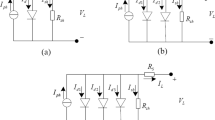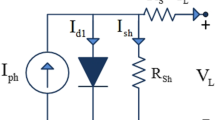Abstract
This paper is concerned with identifying the optimal parameters of solar cell by using a modified spotted hyena optimization algorithm (MSHOA). In the MSHOA, the optimization process initializes random search agents then selects the best agents. The MSHOA modifies the original spotted hyena optimization algorithm by using an accelerating function, which improves the performance of reaching the optimal solution. The convergence occurs rapidly and realizes the global optimization with small iterations number. The numerical results obtained with different models emphasize that the MSHOA has the ability and stability to estimate the global optimal decision variables of solar cell module with a minimal root mean square error compared with other algorithms existed in literature. Moreover, three electrical models called single diode model, double diode model and triple diode model TDM are accurate for depicting electrical behavior of PV modules. It is truth to say that TDM is the most accurate model among the three models. The significant agreements between the estimated model using MSHOA, at different operating temperatures and irradiances, and the measured data assert on the effectiveness of the proposed algorithm and the accuracy of PV model. All results emphasize that the MSHOA is an effective and reliable optimization algorithm for finding the optimal parameters of solar cell modules.







Similar content being viewed by others
Data availability
The manuscript has no associated data.
References
Abbassi A, Gammoudi R, Dami MA et al (2017) An improved single-diode model parameters extraction at different operating conditions with a view to modeling a photovoltaic generator: a comparative study. Sol Energy 155:478–489
Abbassi R, Abbassi A, Jemli M, Chebbi S (2018) Identification of unknown parameters of solar cell models: a comprehensive overview of available approaches. Renew Sustain Energy Rev 90:453–474
Alam DF, Yousri DA, Eteiba MB (2015) Flower pollination algorithm based solar PV parameter estimation. Energy Convers Manag 101:410–422
Asif S, Li Y (2008) Solar cell modeling and parameter optimization using simulated annealing. J Propuls Power 24:1018–1022
Askarzadeh A, Rezazadeh A (2012) Parameter identification for solar cell models using harmony search-based algorithms. Sol Energy 86:3241–3249
Askarzadeh A, Rezazadeh A (2013) Artificial bee swarm optimization algorithm for parameters identification of solar cell models. Appl Energy 102:943–949
Babu BC, Gurjar S (2014) A novel simplified two-diode model of photovoltaic (PV) module. IEEE J Photovolt 4:1156–1161
Bana S, Saini RP (2017) Identification of unknown parameters of a single diode photovoltaic model using particle swarm optimization with binary constraints. Renew Energy 101:1299–1310
Bayoumi AS, El-Sehiemy RA, Mahmoud K et al (2021) Assessment of an improved three-diode against modified two-diode patterns of MCS solar cells associated with soft parameter estimation paradigms. Appl Sci 11:1–20. https://doi.org/10.3390/app11031055
Chang X, Nie F, Wang S et al (2015) Compound rank-$ k $ projections for bilinear analysis. IEEE Trans Neural Netw Learn Syst 27:1502–1513
Chelly Dagdia Z, Avdeyev P, Bayzid M et al (2021) Biological computation and computational biology: survey, challenges, and discussion. Artif Intell Rev 54:4169–4235
Chen X, Xu B, Mei C et al (2018) Teaching–learning–based artificial bee colony for solar photovoltaic parameter estimation. Appl Energy 212:1578–1588
Chen K, Yao L, Zhang D et al (2019) A semisupervised recurrent convolutional attention model for human activity recognition. IEEE Trans Neural Netw Learn Syst 31:1747–1756
Chenouard R, El-Sehiemy RA (2020) An interval branch and bound global optimization algorithm for parameter estimation of three photovoltaic models. Energy Convers Manag. https://doi.org/10.1016/j.enconman.2019.112400
Dhiman G, Kaur A (2018) Optimizing the design of airfoil and optical buffer problems using spotted hyena optimizer. Designs 2:28
Dhiman G, Kumar V (2017) Spotted hyena optimizer: a novel bio-inspired based metaheuristic technique for engineering applications. Adv Eng Softw 114:48–70
Dhiman G, Kumar V (2018) Multi-objective spotted hyena optimizer: a multi-objective optimization algorithm for engineering problems. Knowl-Based Syst 150:175–197
Dhiman G, Guo S, Kaur S (2018) ED-SHO: a framework for solving nonlinear economic load power dispatch problem using spotted hyena optimizer. Mod Phys Lett A 33:1850239
Dizqah AM, Maheri A, Busawon K (2014) An accurate method for the PV model identification based on a genetic algorithm and the interior-point method. Renew Energy 72:212–222
Elazab OS, Hasanien HM, Elgendy MA, Abdeen AM (2017) Whale optimisation algorithm for photovoltaic model identification. J Eng 2017:1906–1911
Elazab OS, Hasanien HM, Elgendy MA, Abdeen AM (2018) Parameters estimation of single-and multiple-diode photovoltaic model using whale optimisation algorithm. IET Renew Power Gener 12:1755–1761
Elsakaan AA, El-Sehiemy RA, Kaddah SS, Elsaid MI (2020) Optimal economic–emission power scheduling of RERs in MGs with uncertainty. IET Gener Transm Distrib 14:37–52. https://doi.org/10.1049/iet-gtd.2019.0739
El-Sehiemy RA, Rizk-Allah RM, Attia AF (2019) Assessment of hurricane versus sine-cosine optimization algorithms for economic/ecological emissions load dispatch problem. Int Trans Electr Energy Syst. https://doi.org/10.1002/etep.2716
El-Sehiemy RA, Hamida MA, Mesbahi T (2020) Parameter identification and state-of-charge estimation for lithium-polymer battery cells using enhanced sunflower optimization algorithm. Int J Hydrogen Energy 45:8833–8842. https://doi.org/10.1016/j.ijhydene.2020.01.067
Fathy A, Rezk H (2017) Parameter estimation of photovoltaic system using imperialist competitive algorithm. Renew Energy 111:307–320
Gow JA, Manning CD (1999) Development of a photovoltaic array model for use in power-electronics simulation studies. IEE Proc-Electric Power Appl 146:193–200
Hasanien HM (2015) Shuffled frog leaping algorithm for photovoltaic model identification. IEEE Trans Sustain Energy 6:509–515
Hasanien HM (2018) Performance improvement of photovoltaic power systems using an optimal control strategy based on whale optimization algorithm. Electr Power Syst Res 157:168–176
Hasanien HM, Al-Durra A, Muyeen SM (2016) Gravitational search algorithm-based photovoltaic array reconfiguration for partial shading losses reduction. In: 5th IET international Conference on renewable power generation (RPG), pp 1–6. https://doi.org/10.1049/cp.2016.0577
Ishaque K, Salam Z, Taheri H (2011) Simple, fast and accurate two-diode model for photovoltaic modules. Sol Energy Mater Sol Cells 95:586–594
Jacob B, Balasubramanian K, Azharuddin SM et al (2015) Solar PV modelling and parameter extraction using artificial immune system. Energy Proc 75:331–336
Jäger-Waldau A (2014) JRC science and policy reports: PV Status Report 2014. Eur Comm DG Jt Res Centre, Luxemb doi 10:941403
Jäger-Waldau A et al (2019) PV status report 2019. Publ Off Eur Union Luxemb
Jia H, Li J, Song W et al (2019) Spotted hyena optimization algorithm with simulated annealing for feature selection. IEEE Access 7:71943–71962
Jiang LL, Maskell DL, Patra JC (2013) Parameter estimation of solar cells and modules using an improved adaptive differential evolution algorithm. Appl Energy 112:185–193
Khanna V, Das BK, Bisht D et al (2015) A three diode model for industrial solar cells and estimation of solar cell parameters using PSO algorithm. Renew Energy 78:105–113
Li Z, Nie F, Chang X et al (2018a) Rank-constrained spectral clustering with flexible embedding. IEEE Trans Neural Netw Learn Syst 29:6073–6082
Li Z, Nie F, Chang X et al (2018b) Dynamic affinity graph construction for spectral clustering using multiple features. IEEE Trans Neural Networks Learn Syst 29:6323–6332
Li Z, Yao L, Chang X et al (2019) Zero-shot event detection via event-adaptive concept relevance mining. Pattern Recognit 88:595–603
Luo M, Chang X, Nie L et al (2017) An adaptive semisupervised feature analysis for video semantic recognition. IEEE Trans Cybern 48:648–660
Monteiro JP, Ramos D, Carneiro D et al (2021) Meta-learning and the new challenges of machine learning. Int J Intell Syst 36:6240–6272
Moshksar E, Ghanbari T (2016) Adaptive estimation approach for parameter identification of photovoltaic modules. IEEE J Photovolt 7:614–623
Muthubalaji S, Kareem MA, Karuppiah N, Sugirtha MG (2017) An enhanced analysis of two diode model PV module under various weather conditions. In: 2017 IEEE International Conference on circuits and systems (ICCS). pp 162–167. https://doi.org/10.1109/ICCS1.2017.8325982
Nishioka K, Sakitani N, Uraoka Y, Fuyuki T (2007) Analysis of multicrystalline silicon solar cells by modified 3-diode equivalent circuit model taking leakage current through periphery into consideration. Sol Energy Mater Sol Cells 91:1222–1227
Oliva D, Abd El Aziz M, Hassanien AE (2017) Parameter estimation of photovoltaic cells using an improved chaotic whale optimization algorithm. Appl Energy 200:141–154
Qais MH, Hasanien HM, Alghuwainem S (2019a) Identification of electrical parameters for three-diode photovoltaic model using analytical and sunflower optimization algorithm. Appl Energy 250:109–117
Qais MH, Hasanien HM, Alghuwainem S, Nouh AS (2019b) Coyote optimization algorithm for parameters extraction of three-diode photovoltaic models of photovoltaic modules. Energy 187:116001
Rahman SA, Varma RK, Vanderheide T (2014) Generalised model of a photovoltaic panel. IET Renew Power Gener 8:217–229
Rajasekar N, Kumar NK, Venugopalan R (2013) Bacterial foraging algorithm based solar PV parameter estimation. Sol Energy 97:255–265
Said M, Shaheen AM, Ginidi AR et al (2021) Estimating parameters of photovoltaic models using accurate turbulent flow of water optimizer. Processes 9:627. https://doi.org/10.3390/pr9040627
Sakr WS, El-Sehiemy RA, Azmy AM (2016) Optimal allocation of TCSCs by adaptive DE algorithm. IET Gener Transm Distrib 10:3844–3854
Sakr WS, El-Sehiemy RA, Azmy AM (2017) Adaptive differential evolution algorithm for efficient reactive power management. Appl Soft Comput 53:336–351
Sandrolini L, Artioli M, Reggiani U (2010) Numerical method for the extraction of photovoltaic module double-diode model parameters through cluster analysis. Appl Energy 87:442–451
Shaheen AM, El-Sehiemy RA (2017) Optimal allocation of capacitor devices on MV distribution networks using crow search algorithm. CIRED Open Access Proc J 2017:2453–2457. https://doi.org/10.1049/oap-cired.2017.0020
Wei H, Cong J, Lingyun X, Deyun S (2011) Extracting solar cell model parameters based on chaos particle swarm algorithm. In: 2011 International Conference on electric information and control engineering, pp 398–402. https://doi.org/10.1109/ICEICE.2011.5777246
Xu S, Wang Y (2017) Parameter estimation of photovoltaic modules using a hybrid flower pollination algorithm. Energy Convers Manag 144:53–68
Yan C, Chang X, Luo M et al (2020) Self-weighted robust LDA for multiclass classification with edge classes. ACM Trans Intell Syst Technol 12:1–19
Yıldız BS (2020) The spotted hyena optimization algorithm for weight-reduction of automobile brake components. Mater Test 62:383–388
Zagrouba M, Sellami A, BouaïchaKsouri MM (2010) Identification of PV solar cells and modules parameters using the genetic algorithms: application to maximum power extraction. Sol Energy 84:860–866
Zaky AA, El Sehiemy RA, Rashwan YI et al (2019) Optimal performance emulation of PSCs using the elephant herd algorithm associated with experimental validation. ECS J Solid State Sci Technol 8:Q249
Zhang D, Yao L, Chen K et al (2019) Making sense of spatio-temporal preserving representations for EEG-based human intention recognition. IEEE Trans Cybern 50:3033–3044
Zhou R, Chang X, Shi L et al (2019) Person reidentification via multi-feature fusion with adaptive graph learning. IEEE Trans Neural Netw Learn Syst 31:1592–1601
Funding
There is no funding provided for that research.
Author information
Authors and Affiliations
Contributions
All the authors contributed in formulating the research idea, algorithm design, result analysis, writing and reviewing the research.
Corresponding author
Ethics declarations
Conflict of interest
The authors declare that they have no conflict of interest. They work at different Government Universities. Their aim purpose is only Scientific and academic research.
Additional information
Publisher's Note
Springer Nature remains neutral with regard to jurisdictional claims in published maps and institutional affiliations.
Rights and permissions
About this article
Cite this article
Gafar, M., El-Sehiemy, R.A., Hasanien, H.M. et al. Optimal parameter estimation of three solar cell models using modified spotted hyena optimization. J Ambient Intell Human Comput 15, 361–372 (2024). https://doi.org/10.1007/s12652-022-03896-9
Received:
Accepted:
Published:
Issue Date:
DOI: https://doi.org/10.1007/s12652-022-03896-9




